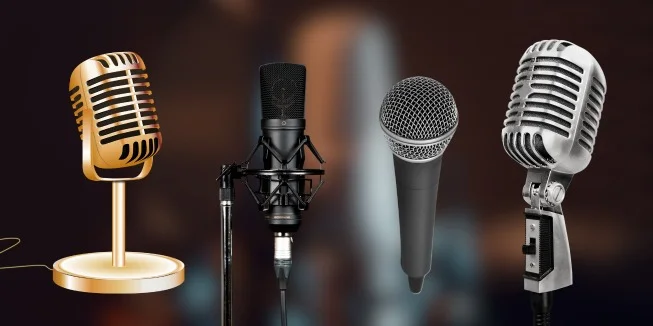Microphones are fundamental tools in audio, converting sound waves into electrical signals for amplification or recording. Grasping the various types of microphones and their specific uses is essential for anyone involved in audio production, broadcasting, or live performances.
For a detailed comparison of the RE20 and SM7B microphones, check out the article comparing RE20 and SM7B microphones to make an informed choice.
How Microphones Work
Before delving into the types of microphones, it’s important to understand their basic operation. Microphones work by converting acoustic energy (sound waves) into electrical signals. This process hinges on transducers—components that respond to changes in air pressure and convert these fluctuations into an electrical current. This fundamental mechanism is key to capturing and translating the subtleties of sound, allowing for effective amplification or recording.
Types of Microphones
Dynamic Microphones
Dynamic microphones are known for their durability and versatility. They operate using a diaphragm attached to a coil of wire within a magnetic field. When sound waves strike the diaphragm, it moves the coil, generating an electrical current.
Condenser Microphones
Condenser microphones are prized for their sensitivity and range. They feature a diaphragm positioned close to a backplate, and variations in distance between these two components alter electrical capacitance, producing the signal.
Ribbon Microphones
Ribbon microphones utilize a thin metal strip (the ribbon) between magnetic poles. When sound waves hit the ribbon, it vibrates within the magnetic field, creating an electrical current. These microphones are celebrated for their warm, natural sound.
Other Types (Carbon and Crystal)
Though less common today, carbon and crystal microphones were once popular. Carbon microphones use carbon granules whose resistance changes under compression, while crystal microphones rely on piezoelectric crystals that generate signals from mechanical pressure.
Subcategories of Microphones
Large-Diaphragm Microphones
These microphones excel at capturing low-frequency sounds and are commonly used in studio settings for vocals and instruments.
Small-Diaphragm Microphones
Small-diaphragm microphones are known for their precision in capturing high-frequency sounds, making them ideal for detailed audio in orchestral and acoustic recordings.
Lavalier Microphones
Lavalier microphones are small, clip-on devices used in broadcasting and public speaking, offering hands-free operation and discreet placement.
Shotgun Microphones
Shotgun microphones have a highly directional pickup pattern, suited for capturing sound from specific sources. They are often used in film and television.
Multi-Pattern Microphones
These microphones offer multiple polar patterns, allowing users to switch between different configurations to suit various recording scenarios.
Polar Patterns of Microphones
Understanding a microphone’s polar pattern is essential for optimal sound capture. Polar patterns dictate a microphone’s sensitivity to sounds from different directions.
Cardioid Microphones
Cardioid microphones are most sensitive to sounds from the front and least sensitive to those from the rear, making them ideal for recording single sources.
Supercardioid Microphones
These have a narrower pickup pattern than cardioid microphones, focusing even more on the desired sound source.
Omnidirectional Microphones
Omnidirectional microphones pick up sound equally from all directions, providing a natural, spacious sound. They are ideal for recording ambient sounds or multiple sources.
Figure-8 Microphones
Figure-8 microphones capture sound from the front and rear while rejecting side sounds. They are useful for recording two sources simultaneously.
Choosing the Right Microphone
Selecting the right microphone involves considering factors like the microphone’s intended use, environmental conditions, and the characteristics of the sound source. Key considerations include sensitivity, frequency response, and durability. Assessing these factors will help you choose a microphone that meets your recording or performance needs.
Microphone Applications: Best Choices for Different Uses
Microphones are designed for various applications, from recording vocals and instruments to podcasts and field recordings. Understanding the unique characteristics of each microphone type is crucial for achieving the best audio quality. Whether you’re a musician, podcaster, or audio engineer, selecting the right microphone for your specific needs ensures high-quality results.
Conclusion
The microphone landscape is diverse, offering numerous options to meet different recording needs. Whether you’re a professional audio engineer, content creator, or musician, knowing the main types of microphones and their applications will help you make informed decisions. By considering factors such as microphone type, polar pattern, and subcategories, you can ensure your recordings and performances achieve the highest quality.


